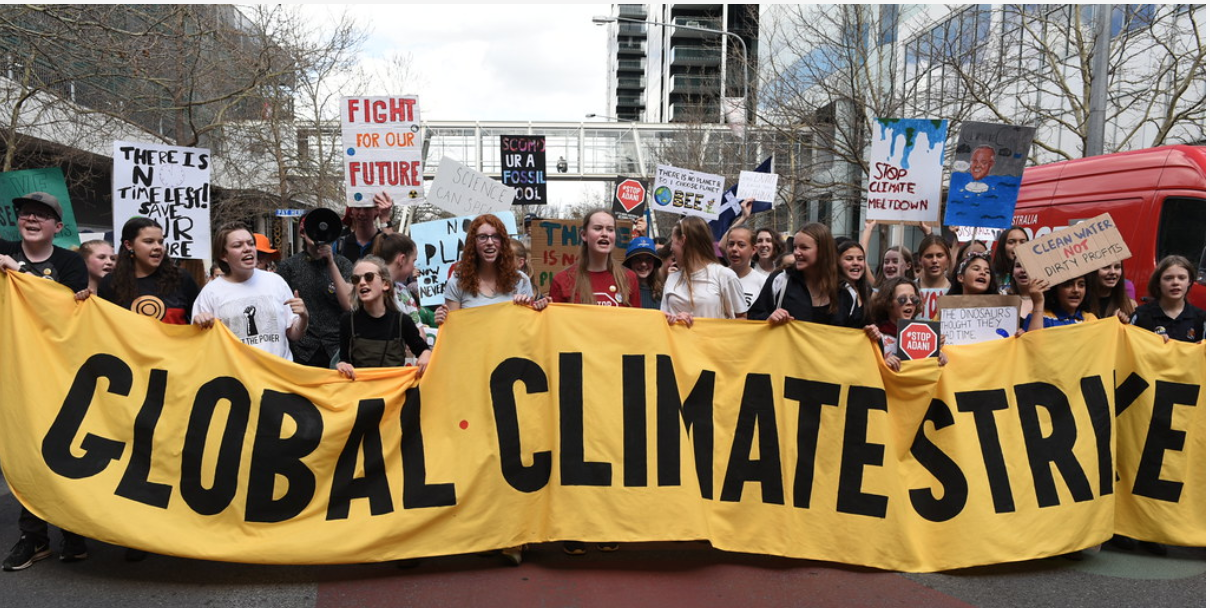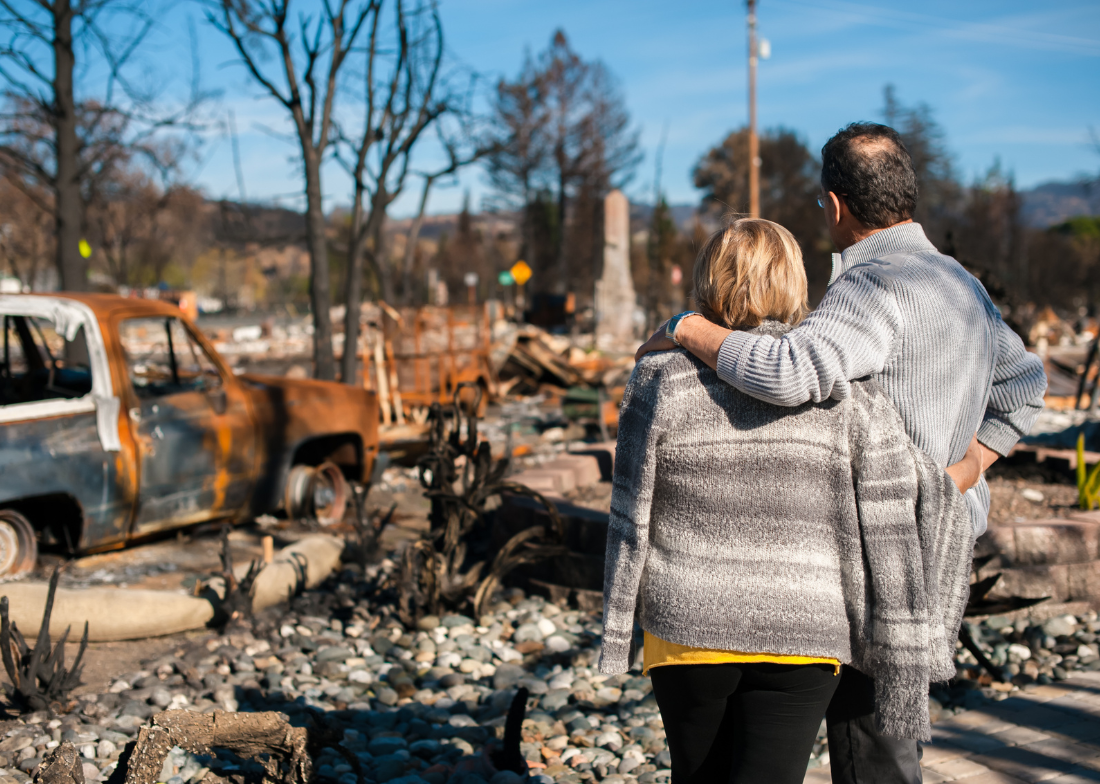Climate Change is a Threat Multiplier
Indi Howeth
|November 14, 2020

For many years, the conversation about climate change has revolved around its impacts on animals and ecosystems. If not that, much of the rhetoric involves grandiose diagnoses about the world ending in a decade or so. And while polar bears on melting ice caps and policy deadlines are essential to fighting climate change, they can sometimes be ineffectual in spurring everyday people with busy, complex lives into climate action. What much of the climate movement lacks is a focus on the impacts that are and will have tremendously negative effects on everyday, individual lives, particularly BIPOC (Black, Indigenous and People of Color).
SNL Weekend Update host Michael Che once joked in a segment about the 2018 U.N. Climate Change Report, which prescribed 2030 as the deadline to enact extreme climate policy change to avoid catastrophic effects, that he had been trying to figure out all week, “Why don’t I care about this?” He explained that environmentalists “keep telling us we’re gonna lose everything and nobody cares about everything, people only care about some things.” This was just a joke, but it’s true. It’s hard to ask people to care about the whole world ending in a few decades because it feels too overwhelming and distant of a problem to feel inspired to actually do something about it. The reality is that climate change is already having an immense impact on people’s lives, not just directly because of higher average temperatures, but also because climate change is a threat multiplier. That means that the direct effects of climate change, like extreme heat and warmer water, are responsible for exacerbating other societal tensions, including:
- Extreme Weather Events
- Famine
- Housing Crises
- Health Problems
- Immigration
- Political Conflict
Let’s break those down.
Extreme Weather Events
The term extreme weather events generally refers to events which have traditionally been categorized as natural disasters: wildfires, hurricanes and major flooding, for example. While these events have always occurred, the increasing global temperatures of the last century have dramatically increased both the frequency and severity of such events. On the West Coast, firefighters, like Butte County, California Fire Chief, John Messina, lament that “each year gets worse.” He explained, with a 30-year career with Cal Fire, that he and his fellow firefighters “used to talk about 5,000 acres being a big fire.” In mid-September of this year, when he made those comments, the North Complex he and his team were fighting was already 50 times that size, but only the fourth-largest fire this year in California. Governor Gavin Newsom of California echoed his sentiment: “it was just two years ago that this area saw the deadliest wildfire in our history. Now, just a few miles away, another deadly wildfire has ripped through these same communities. There is no doubt—climate change is here, and it is happening faster than most had anticipated.”
In the southeast, hurricanes and major flooding threaten communities’ livelihoods each year- especially BIPOC communities who often can’t as readily up and leave from disaster-prone places. In a livestream put on by The Alliance for Climate Education earlier this month, founder of Miami’s “The Sink or Swim Project,” Delaney Reynolds, explained that while Miami currently faces about six major flooding events per year this is likely to increase to 80 per year by 2030 and by 2045, 3,080 of these events per year, which as Reynolds pointed out means these events would likely happen multiple times in one day. In the same conversation, Gabriela Rodriguez, of the CLEO Institute, added that by 2050, “One-third of [her] year [would be] too hot to live in Miami,” where she currently resides and pointed out that “affordable housing in the U.S. does not currently require air conditioning.
Disabled folks, especially those with physical impairments such as those who use a wheelchair, are often left out of emergency evacuation plans. Someone who uses a wheelchair and is unable to walk will not be able to use the stairs when the elevators aren’t safe to use in an emergency situation. Additionally, those with visual, hearing, mental or other impairments may face increased difficulty in accessing necessary emergency information or otherwise face extra challenges when evacuating due to an extreme weather event. These folks comprise yet another demographic who disproportionately face the negative consequences of climate change.
2019 is the 6th consecutive year that the U.S. has had 10 or more billion-dollar extreme weather events. Extreme weather events are undoubtedly increasing in frequency and severity and are having extreme effects on people’s lives: loss of property and shelter, loss of a food or water source, increased chance of mental health concerns and, among others, loss of life. One such consequence that both extreme heat and weather events contribute to is famine.
Famine
In 2018, the UN warned that climate change was the new driving factor in world hunger,- citing “extreme weather events, land degradation and desertification, water scarcity and rising sea levels.” The science of this is pretty straightforward: crops need a reliable climate to grow. For about every 1.8°F increase in global average surface temperature, there is a 10% decline in yields of the world’s major grain crops: corn, soybean, rice and wheat. To put this into perspective, as stated by the Physicians for Social Responsibility, “climate experts predict that global temperature may rise as much as 5.4°F to 9°F if we continue burning fossil fuels at our current rate. This could lead to 30% to 50% declines in crop production.” Without the ability to reliably and consistently produce food, whole populations have and are already facing extreme famine.
Currently, 24 million people in Yemen are food insecure. Yemen’s total population is only about 29 million. That means about 80% of Yemen’s entire population is food insecure – and that’s with foreign aid. The United Nations World Food Programme has already called this level of hunger, “unprecedented.” In the U.S., about 35 million people currently face hunger. The U.S. population is about 331 million in total, making the percent of Americans facing hunger about 11% of the country’s population. That may seem small, but remember, that’s about the size of Florida’s entire population…doubled. As global average temperatures increase, this will only cumulatively worsen.
Housing Crises
More extreme weather events, heat waves, and the rising sea level are all sure to intensify housing crises, particularly for BIPOC communities. There are two main phenomena at play here. One is a person or household’s ability to flee an emergency or extreme weather event. While some people may have the resources – money, language ability, community ties – to flee an area and secure safe shelter quickly, others do not have the same accessibility to these resources. Poor folks may not be able to afford to stay in a hotel, non-English speakers may not be able to understand emergency news updates and those without certain legal statuses may not have access to receiving necessary federal aid. All of these challenges are faced more frequently by BIPOC individuals.
Another aspect that contributes to worsening the current housing crisis is the phenomenon of climate gentrification. Climate gentrification is defined as wealthier, often white, populations moving into areas less affected by climate change. Many of these areas have historically been occupied by lower-income and BIPOC communities. For example, someone with an expensive beachfront home might move inland, in traditionally less expensive neighborhoods, due to sea level rise threatening ocean front homes. By 2050, around 800 million people living in coastal cities around the world will likely be vulnerable to sea-level rise and coastal flooding. Once the wealthier, predominantly white populations move into historically low-income and predominantly BIPOC neighborhoods, those families are forced to move out to more affordable locations. However, those more affordable locations are often the most impacted areas by climate change. Moreover, governments often invest more money into maintaining areas less impacted by climate change. This poses a huge threat to the low-income and BIPOC folks who are forced to put themselves at a much higher risk of facing the most severe impacts of climate change of which they comparably already have the least amount of resources to combat and adapt to.
Additionally, this issue heavily impacts the LGBTQ+ community. LGBTQ+ youth represent as much as 40% of the homeless youth population, mostly due to familial rejection. While climate change will likely not directly increase the amount of LGBTQ+ youth facing homelessness, this statistic demonstrates how this community will disproportionately be impacted by climate change as it makes homelessness – the sheer lack of shelter – severely more dangerous.
Health Problems
Climate change exacerbates people’s health problems in a variety of ways. Between 2030 and 2050, climate change is estimated to cause 250,000 additional deaths per year. This estimation includes deaths from malnutrition, malaria, diarrhea and heat stress. People’s health is also affected by other events exacerbated by climate change, like extreme weather events. In addition to physical harm, about 50% of people suffer depression after surviving an extreme weather event. Moreover, many people, particularly youth, experience levels of stress and anxiety about a future overcome by the most catastrophic consequences of climate change. One Kaiser Family Foundation poll of American teenagers, released in September of 2019, found that as many as 57% of U.S. teens said climate change made them feel scared. That number grew to 68% for people aged 18-29.
Black folks are about 40% more likely to have asthma than white folks. And Native Americans are 60% more likely than white Americans. This is due to the environmentally racist systematic documented practice of putting fossil fuel factories and oil refineries in or in close proximity to predominantly BIPOC neighborhoods. BIPOC individuals are far more likely to face a multitude of health risks associated with consistently breathing heavily polluted air. While this is not necessarily a result of climate change, both issues derive from the same problem: fossil fuel pollution. Additionally, the higher likelihood of BIPOC individuals developing these conditions makes them even more vulnerable to the already existing increased health problems posed by climate change.
Overall, climate change increases Americans’ health problems: the likelihood of developing them, worsening them and the likelihood of effectively treating them.
Immigration
There are many reasons why a person might immigrate, but a lot are exacerbated by climate change. In 2017, around 22.5-24 million people were displaced from their homes due to extreme weather events, more than any other year. But extreme weather events are not the only reason that climate change contributes to higher amounts of people immigrating. Famine, lack of access to housing, education, employment and even political conflict and violence can all be tied back to the effects of climate change and are all reasons why a person might immigrate. As a reflection of this reality, The 2020 Ecological Threat Register estimates that by 2050, upwards of 1.2 BILLION people could be displaced due to climate-related issues.
People who immigrate due to climate-related issues are often referred to as “climate refugees.” However it is important to note two things. First, the legal definition of a refugee differs from that of an asylee. While both those who are granted refugee and asylee legal status in a country must apply based on having a fear of persecution in their country of origin, a refugee completes this application while not yet within the country in which they seek legal status, while an asylee applies once they have already arrived in that country. In other words, in terms of legal definition, it is important to include the term “climate asylee” in our vocabulary as there are many probable instances – especially in regard to people fleeing from sudden, extreme weather events – where it would be more appropriate to label someone as a “climate asylee,” rather than a “climate refugee”. This is incredibly important in terms of policy implication of their legal definitions.
The second important thing to note about the term “climate refugee,” is that while people commonly use the term, there is actually, currently, no legal definition in U.S. or international law of either a “climate refugee,” or a “climate asylee.” In other words, no country, including the U.S. has any policy or program in place that is readily equipped to aid the billions of people displaced from extreme weather events in the coming decades.
Last year, Senator Ed Markey introduced a bill titled the “Climate Displaced Persons Act,” which would grant legal stay for a minimum of 50,000 climate migrants each year. It has yet to be voted on.
Political Conflict
While research on the relationship between climate change and political conflict is still a very nascent field, based on the research available, it is reasonable to conclude that as the effects of climate change worsen, so too will political conflict and violence, especially in regions most affected. This is true for two main reasons: first, higher temperatures have been proven to increase the presence of violence in a society and second, much of political conflict revolves around a competition around access to natural resources – something increasingly threatened by climate change.
A recent study conducted at the University of Southern California and published by the National Bureau of Economic Research, analyzed the “crime reports, arrest counts and service call records from 2010 to 2017 from the Los Angeles Police Department, the country’s third-largest police department.” They found a 2.2 percent increase in general crime and a 5.7 percent increase in violent crime, on average. While global average temperatures increase, people are more likely to get irritated by the heat and act out violently.
Published by the peer-review journal, Annual Reviews, political scientist Vally Koubi explains two other reasons why climate change is likely to increase political conflict. The first is the idea that political conflict derives from competing interests over scarce resources. As he points out, some researchers believe factors like ineffective political systems or actors of certain countries to be too big of confounding variables to suggest that climate change directly results in increased political conflict. However, whether or not climate change is a direct cause of political conflict, the increased scarcity of resources is sure to exacerbate conflict, especially if a country is already prone to political unrest. The second reason that Koubi discusses as to why the effects of climate change results in an increase in political conflict is “indirect pathways,” such as “economic output,” and “migration.” Economic-depletion from extreme weather events, drought, famine etc. and increased migration have all been linked to an increase in political conflict. Thus, in this way, climate change indirectly causes an increase in political conflict.
None of these problems are new phenomena, however, the direct effects of climate change, like warmer temperatures and warmer water, are all drastically exacerbating them. This will only continue to worsen. Yes, climate change is about big numbers and scary policy deadlines and even some apocalyptic rhetoric. But at the center of every climate change discussion is an individual person being affected by climate change in very personal, traumatic and lasting ways. These are the people we must focus on. These are the people we must fight for. These are the people behind the movement.
Want to read more? Check out the ACE Blog.
Join our Youth Action Network
More Blog Posts
Driving India towards self sufficiency and freedom from oil
India can shield itself from oil-price shocks and global pressure over Russian barrels by leaning harder into two strengths it …
Read More
Unnatural, Not Unprecedented
For two weeks, residents of Southern California endured a waking nightmare. Parents raced against time – hurrying down the driveway …
Read MoreCrafting a Vision for the Future: My Experience at LCOY USA 2024
Dry and sunny Tempe, Arizona where temperatures have been over 100 F for 113 consecutive days, delegates gathered to attend …
Read More
